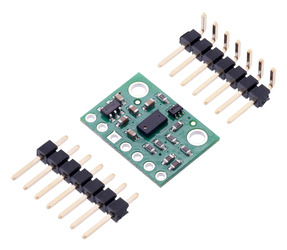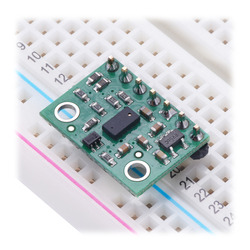Small, cheap ($13) laser ranger finder with 2m range and less noise than sonar. Sign me up!
The VL53L0X from ST Microelectronics is a time-of-flight ranging system integrated into a compact module. This board is a carrier for the VL53L0X, so we recommend careful reading of theVL53L0X datasheet (1MB pdf) before using this product.
The VL53L0 uses ST’s FlightSense technology to precisely measure how long it takes for emitted pulses of infrared laser light to reach the nearest object and be reflected back to a detector, so it can be considered a tiny, self-contained lidar system. This time-of-flight (TOF) measurement enables it to accurately determine the absolute distance to a target without the object’s reflectance greatly influencing the measurement. The sensor can report distances of up to 2 m (6.6 ft) with 1 mm resolution, but its effective range and accuracy (noise) depend heavily on ambient conditions and target characteristics like reflectance and size, as well as the sensor configuration. (The sensor’s accuracy is specified to range from ±3% at best to over ±10% in less optimal conditions.)
Ranging measurements are available through the sensor’s I²C (TWI) interface, which is also used to configure sensor settings, and the sensor provides two additional pins: a shutdown input and an interrupt output.
The VL53L0X is a great IC, but its small, leadless, LGA package makes it difficult for the typical student or hobbyist to use. It also operates at a recommended voltage of 2.8 V, which can make interfacing difficult for microcontrollers operating at 3.3 V or 5 V. Our breakout board addresses these issues, making it easier to get started using the sensor, while keeping the overall size as small as possible.
The carrier board includes a low-dropout linear voltage regulator that provides the 2.8 V required by the VL53L0X, which allows the sensor to be powered from a 2.6 V to 5.5 V supply. The regulator output is available on the VDD pin and can supply almost 150 mA to external devices. The breakout board also includes a circuit that shifts the I²C clock and data lines to the same logic voltage level as the supplied VIN, making it simple to interface the board with 3.3 V or 5 V systems, and the board’s 0.1″ pin spacing makes it easy to use with standard solderless breadboards and 0.1″ perfboards. The board ships fully populated with its SMD components, including the VL53L0X, as shown in the product picture.
For a similar but shorter-range sensor (up to 20 cm, or 60 cm with reduced resolution) that includes ambient light sensing functionality, see our VL6180X carrier.
VL53L0X datasheet graph of typical ranging performance (in default mode).
Specifications
- Dimensions: 0.5″ × 0.7″ × 0.085″ (13 mm × 18 mm × 2 mm)
- Weight without header pins: 0.5 g (0.02 oz)
- Operating voltage: 2.6 V to 5.5 V
- Supply current: 10 mA (typical average during active ranging)
- Varies with configuration, target, and environment. Peak current can reach 40 mA.
- Output format (I²C): 16-bit distance reading (in millimeters)
- Distance measuring range: up to 2 m (6.6 ft); see the graph at the right for typical ranging performance.
- Effective range depends on configuration, target, and environment.
- The datasheet does not specify a minimum range, but in our experience, the effective limit is about 3 cm.
Included components
A 1×7 strip of 0.1″ header pins and a 1×7 strip of 0.1″ right-angle header pins are included, as shown in the picture below. You can solder the header strip of your choice to the board for use with custom cables or solderless breadboards, or you can solder wires directly to the board itself for more compact installations.
|
|



Comments
Its exiting thinking that belts harvesting dozens of those chips will provide us with decent FOV SLAM real soon :)
:(
I've now tested this outside in bright sunlight. Totally useless -- range is like 10cm. Use it indoors only
Update: I've now got this up and running. Works great (more accurate than sonar indoors) and very easy to use, but it's absolutely limited to less than 2m. Totally useless beyond that.
I worked at a company that used a cheap ground proximity sensor (sonar). It was the cause of a large percentage of the crashes we had. I would guess 50%. I think linking the logic to the altimeter to reduce the chance of false positive ground detection is definitely worth considering. Face it this is a major safety issue and not shutting off on landing is less of a problem. From 30 m in a stiff breeze a vehicle can easily be blown into people not to mention impact it can have on someone like Rob who is trying to build a business.
We've had the opposite problem of not disarming on landing but we just turn up the descent rate. On the balance the code has worked exceedingly well for us. Having a proven mechanical switch option doesn't sound like a bad option.
@ Rob: if it may cheer you up: http://www.bbc.com/news/uk-wales-mid-wales-37082095
quote from the aerticle: An investigation report found the UAV's software falsely detected a landing when the aircraft was still in the air.
LD, I totally agree that it would be great if all UAV had real AGL sensors. The problem has just been the cost, really. That's why things have evolved the way they have. A barometer is like $0.50, and a Lidar is $300+
Hi! This is awesome, i like to buy one. Do you have an alternative warehouse in europe?
Its like 15usd shipping and +27%tax on the whole if i order from there. Maybe can you send me as a gif in a simple mail?
Thanks,
M.
VTOL's have their own set of problems! It seems that some parts of them still want to fly when the others want to land.
To landing flying things, maybe it's possible to detect a change in flight dynamics when it gets close to the ground, (WIG, turbulence, pulsating sensors etc) and use that to "arm" the landing detection. That way at least the landing detection can't disarm the aircraft.
How about adding a filter/error correction to the barometer readings by using the accelerometer readings to compare? If they are both mounted to the same PCB and the sensor update rate is fast enough, it should negate the need for a second baro in a different orientation, and could be added as a simple software upgrade. Isn't something like that already being done as sensor fusion?
-
1
-
2
-
3
-
4
-
5
of 5 Next